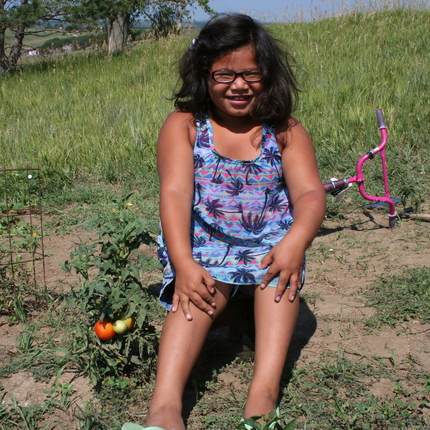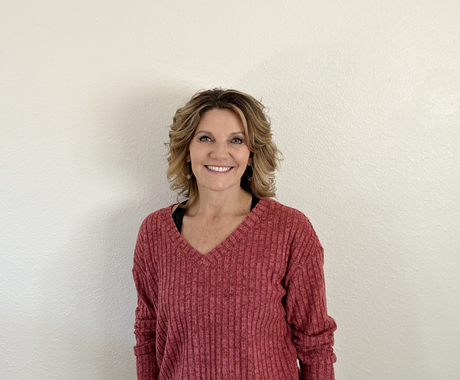Sharon Freemont sits on a stool in the evening, weeding the garden. Sometimes her three grandchildren join her.
The garden is surrounded by high grass, and beyond that, fields, shaded in the evening by a lone tree.
“It’s nice in the evening, I sit, relax and meditate,” Sharon said. “We sit and look at what we’ve done, it’s something we did all by ourselves.”
The family has a small garden at their home three miles outside of Walthill, Neb., on the Omaha Reservation.
Sharon grew up in the area, eating vegetables from her parents’ and grandparents’ gardens. Her parents were also raised with gardens.
“We had a big, big garden, that’s what we lived on,” Sharon said. “My aunt did tomatoes, and we froze corn.”
For 20 years, she has wanted a garden, and with a little help from the Center for Rural Affairs, she finally has one.
“I didn’t know what I was doing,” Sharon said. “I’m so happy about my vegetables. I honestly didn’t believe they’d grow. If it wasn’t for Suzi [French] and your program, I wouldn’t be at this point.”
Sharon and other members of the Omaha and Santee Sioux Tribes are working hard to improve access to fresh, nutritious food grown in their own communities, often in their own backyards. And the Center for Rural Affairs is working alongside them.
In each community, Center staff has provided demonstrations with garden tilling, seeds and starter plants, and supported new farmers markets. They regularly make garden visits throughout the growing season.
I joined Suzi French, community food specialist, on one of those visits to Sharon’s place. When we stopped by, we took a look at the plot, finding a ripening tomato and a pepper. We pointed the veggies out to Sharon, and Suzi let her know they were ready to be picked.
“That tomato is going to be only mine, I can’t wait to eat it,” Sharon said.
She wishes to pass on the knowledge of gardens to her grandchildren. When more produce is ready, she intends on making dishes with fresh vegetables.
“We have to get the kids back to healthy snacks,” Sharon said. “I want my grandchildren to learn instead of going to the store - it’s expensive.”
Sharon started out with a handful of plants provided by the Center, and purchased a few plants on her own – large tomatoes, green beans, cucumbers, watermelon and rhubarb.
Before we left, Suzi gave Sharon advice on what plants were weeds, and encouraged Sharon to keep watering and tending to the garden. Suzi said the ground in the plot is hard this year, but they will fertilize and lay down cardboard at the end of this growing season so it will be better next year.
“Next year I want to do a lot more,” Sharon said. “This is an experiment more than anything.”
Center staff work in the communities year-round, also assisting and training food preparation and preservation techniques.
When we visit each community, it’s not hard to find the impact of our garden and market projects over the past three years. Gardens can be spotted in several yards, with more than 50 in Santee, and 100 in Macy, Walthill, Rosalie and in between. And farmers markets are held regularly in Macy, Walthill and Santee.
“We are doing it! We are growing our very own fresh food,” Suzi said. “We are eating it, sharing it and some are selling it. We are teaching our children about growing food. We are changing our food system.”
Pictured: Sharon Freemont’s granddaughter, Maddy, shows off a ripe tomato in their garden. Sharon gardens outside of Walthill, Neb., on the Omaha Reservation. | Photo by Rhea Landholm





